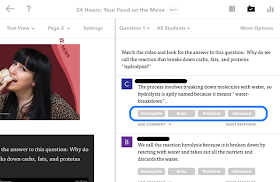.jpg) I remember the day the principal brought me my set of SMART Response clickers. At that time, I wasn't a huge SMARTboard enthusiast, so I mostly mocked the clickers. Until I tried them. I had been circulating in my room while we did practice problems for years and felt I had a pretty good take on who understood what, but as soon as I passed out the clickers, I somehow upped the ante. Though I used them anonymously back then, the students felt extra pressure to answer correctly. They wanted to be right when they submitted their answers. Now I have tried out a lot of student response systems, but I really couldn't get my head around this one until I tried it. Once I did, it was super-easy and really fun. A Plicker is a Paper Clicker. A nice, low-cost, simple solution for a classroom without much technology. Or even with a ton of technology. One device it all it takes.
I remember the day the principal brought me my set of SMART Response clickers. At that time, I wasn't a huge SMARTboard enthusiast, so I mostly mocked the clickers. Until I tried them. I had been circulating in my room while we did practice problems for years and felt I had a pretty good take on who understood what, but as soon as I passed out the clickers, I somehow upped the ante. Though I used them anonymously back then, the students felt extra pressure to answer correctly. They wanted to be right when they submitted their answers. Now I have tried out a lot of student response systems, but I really couldn't get my head around this one until I tried it. Once I did, it was super-easy and really fun. A Plicker is a Paper Clicker. A nice, low-cost, simple solution for a classroom without much technology. Or even with a ton of technology. One device it all it takes.
The Set-Up: I went to plickers.com and created my free account. Then I created 5 classes for the high school classes I teach. I added my students by first name and last initial. All very simple! Then I printed out the plickers from here. Each of my students would receive a unique paper clicker that I assigned with a number in my account. I copied them onto heavy cardstock and made 6 sets, one for each class and one class set that will live in the room for when students don't have one.
 The Try-Out: I ask a question with a multiple choice answer and give the students the choices. I did this verbally, but you could use a worksheet or notes page with the choices if you want to plan it all out ahead of time. Students hold the plicker in one of its four directions to indicate which answer they think is correct. I scan the plickers. The iPad shows who has been scanned and how they answered. I can also see at a glance how many students have the correct answer. You can create questions ahead of time or on-the-fly. With some practice, I could easily scan the entire room from one spot.
The Try-Out: I ask a question with a multiple choice answer and give the students the choices. I did this verbally, but you could use a worksheet or notes page with the choices if you want to plan it all out ahead of time. Students hold the plicker in one of its four directions to indicate which answer they think is correct. I scan the plickers. The iPad shows who has been scanned and how they answered. I can also see at a glance how many students have the correct answer. You can create questions ahead of time or on-the-fly. With some practice, I could easily scan the entire room from one spot.In the picture at the left, I have scanned 21 of my 22 students in the class - only Gabe L has not been scanned. Notice the names on the screenshot; they pop up as they are scanned and their names turn blue in the boxes at the top of the screen. I can also see how they answer.
The Drill-Down: After my lesson, I can look at the data. Green squares show correct answers; red show wrong answers. I can see which students chose each answer in case I need to target specific remediations. Again, very simple and intuitive. In the screenshot at the left, I can see which answer every student chose. I can also see how many picked each choice and that 70% had the answer correct.
The Weigh-In: My students thought the plickers were fun to use. I had a SMART Response task lined up for them before vacation and it wasn't working, so one of my students suggested we use plickers instead. Everyone reached in their binders and pulled them out and we were back to reviewing for the test. I love the simplicity of this tool and the ease of data collection. Of all the student response systems I have tried, it was easiest to set up and use with a big pay-off in the data it provides, so I am adding it to my apps page.
.jpg)


.jpg)
.png)
.png)




















.jpg)
.jpg)


